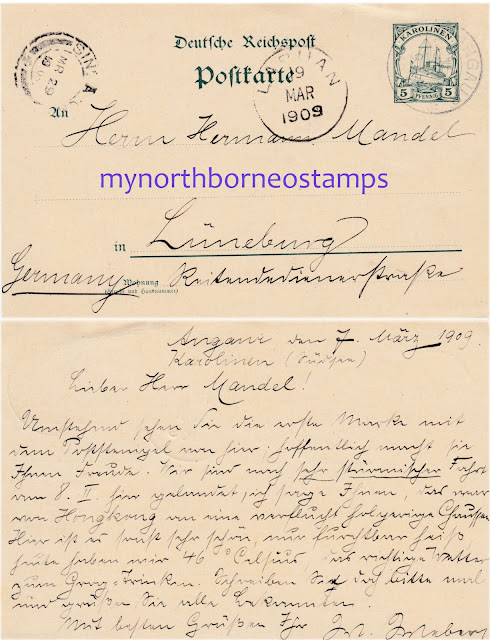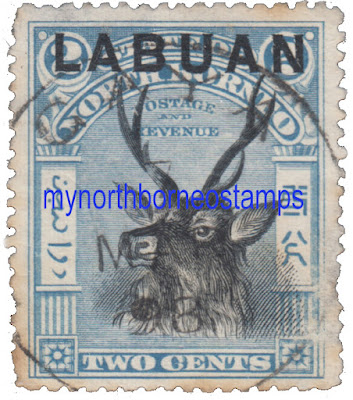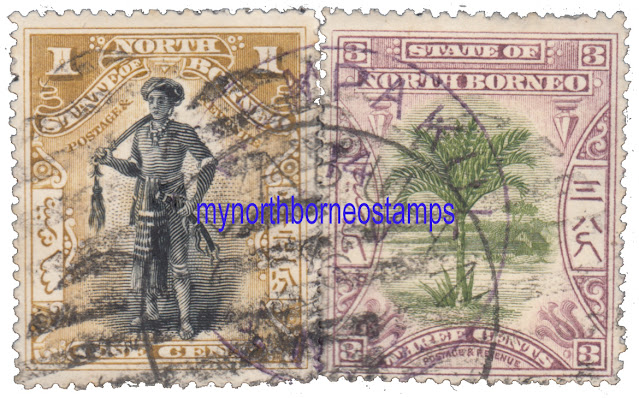Monday, 15 December 2025
North Borneo Air Mail rates in 1936
I do not specialise in collecting air mails even though I have some nice items. This is an original post office notice from Horace Dabell, the postmaster General in 1936. It may of use to readers who are doing research on airmail rates from North Borneo of this period.
Tuesday, 25 November 2025
North Borneo 1961 10c value with broken right inner frame line
The North Borneo 1961 issue and subsequent overprints in 1964 has many variations and varieties that are not catalogued. Waterlow & Sons only did one printing run before the business was sold and eventually taken over by Thomas De La Rue in 1961. DLR did reprinting of the stamps in different tranches. There were differences when compared to the printing done by Waterlow especially in the perforation patterns. The main alteration being that the bottom margin of the printed sheet was left unperforated to the margin of the selvedge by Waterlow but perforated through at the top. The DLR printed sheets were directly the opposite in addition to other patterns of perforation as well as varying selvedge margins.
There were also slight differences in shade with some of the values. One of the varieties that has been recognised in recent years is that in some of the 10c stamps, presumably DLR reprints, has an imperfect right inner frame line as shown below.
Sunday, 17 August 2025
Variations of the Labuan D8 cancellation
The double ring Labuan D8 cancellation was used during the administration by the Straits Settlements between January 1910 and August 1913. In common with Straits cancellations of that period, it has a time or letter code which is sometimes omitted even though I do not have an example to show it here. The known letters used are A,B,C,D and E.
Friday, 18 July 2025
A Labuan transit stationary postcard from the German Caroline Islands
This is a very unusual and rare item of postal history with a Labuan connection. It was posted at Angaur which is the southernmost island in the chain of islands called the Carolines in the western Pacific to the north of New Guinea. The islands to the extreme west including Angaur is now known as the Republic of Palau.
Historically, they were claimed by the Spaniards in 1528 and became part of the Spanish East Indies and were also known as the New Philippines, being governed from Manila. After their defeat by the Americans, Spain sold these islands to Germany in 1899. They were under German administration as part of German New Guinea until their defeat in WWI in 1918.
The island of Angaur was very rich in organic phosphates which were mined between 1909 to 1954. This card was definitely sent by one of the expatriate employees there. It was believed that there were several routes for mail to travel from the Carolines to Europe depending on the trade routes used by visiting German steamships. One of these routes was suppose to involve the regular visit of Angaur by one of the NDL ships which served Singapore, Labuan, North Borneo and Zamboanga in south Philippines. It has been said that this was monthly schedule. But there is no evidence to support this at all. As far as records in the BNBC Herald shows, the service only went as far as Zamboanga.
It was written on 7 March 1909, posted on 9-3 09 and transited Labuan on 19 MAR 1909 and Singapore MR 29 1909. A ship journey of 10 days between Angaur and Labuan was very fast even for nowadays. Moreover, looking at the shipping information on shipping arrivals and departures from Sandakan, I am unable to trace the ship with the right timing at Sandakan nor the journey to Labuan. The transmission of this card is not that straightforward.
Friday, 11 July 2025
Some nice cancellations

Saturday, 28 June 2025
Some recently acquired maps of North Borneo
I recently acquired these maps as part of a private philatelic collection which also included some amazing old North Borneo postal and fiscal cancellations which may in time appear on these pages.
Thursday, 19 June 2025
Around the world covers that visited North Borneo
These two items are plainly philatelic and contrived by the same person in Scotland UK. Otherwise, it would be impossible to see such beautiful and interesting covers. The process was actually quite complicated and involved cooperation and help from friends and contacts in these countries.
Thursday, 9 January 2025
Early North Borneo and Labuan Sanbride postcards
About 15 years or more ago before the colour postcards of Borneo were printed by Sanbride, there was a series of monochromic postcards published by F & K Chinn showing Kudat and Labuan and printed by Sanbride. Conceivably, there are others apart from these four here which are the only ones that I have seen so far. Chinn was probably based at Kudat.
The card has a divided back for a postcard of North Borneo from 1906. No written message was allowed on this side prior to 1906 or the lower postcard postal rate would have been forfeited.
I have found another postcard of this series on the net. They are probably some others.










































